Guyana Focus
little specifics

Titled the "Journey to the Good Life Continues", Guyana’s fourth budget under the two-and-a-half year old APNU+AFC regime was long on talk about proposed plans and programs but short on strategic and tactical initiatives.
The budget focused primarily on what the government has supposedly achieved since it came to office in 2015 and what it plans to achieve in 2018 and future years - without any specific measures on how it proposes to achieve its goals.
The absence of specific, measurable targets leaves scope for shortfalls and a lack of accountability for budgetary expenditures – although the government promised greater transparency and accountability.
The total $267.1 billion 2018 budget, which is 7.1% greater than the revised 2017 budget, was presented against the backdrop of a slowing economy, which grew by 2.9 % in 2017, versus a target of 3.8%.
The 2018 inflation rate is projected at 2.4%, up from the 2017 estimated rate of 2%, which is lower than the initial target of 2.5%.
Incidentally, GDP growth in 2018 is also forecast at 3.8%, with growth excluding the sugar industry anticipated to be 4.6%. The sugar industry, which is expected to decline by 24% in 2018, will continue to be a drag on economic growth.
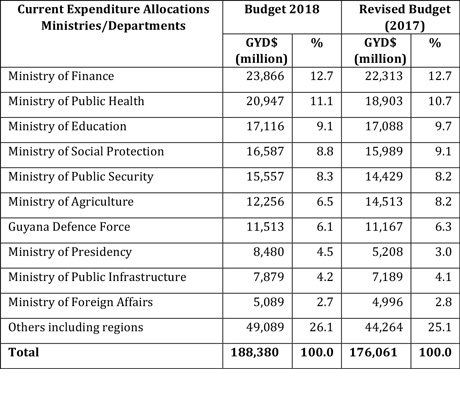
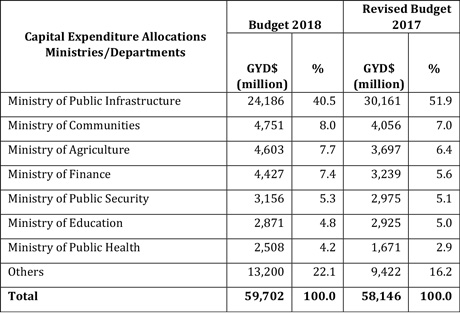
While sugar is expected to experience the largest decline in output in 2018, bauxite is forecast to benefit from the largest increase in production at 23% over 2017 output. The construction sector is expected to grow by 15%, forestry by 8%, mining and quarrying by 5%, gold by 3.3%, rice by 2.5%, fishing by 2.3% and livestock by 2%. The Agriculture, Fishing and Forestry sector as a whole is expected to decline by almost 1%. This is in spite of the government’s focus on diversifying agriculture.
Current expenditure, which includes employment costs, statutory expenses and other charges for the 2018 year is budgeted at $188.4 billion, which is 7% more than the revised 2017 budget.
According to Ram & McRae, Chartered Accountants, salaries have increased from GYD $31,345 million in 2011 to a projected GYD $58,952 million in 2018, an increase of 47%.
Table 1 shows the Ministries/Departments with the most significant allocations and the largest changes between 2017 and 2018.
Capital expenditure for 2018 is budgeted at $59,702 million, representing a projected increase of $1,556 million or 3% over the revised 2017 budget of $58,146 million. Table 2 provides a breakdown of capital expenditure.
In its analysis, Ram & McRae noted that the total budget for the Police and Army is $24.2 billion, up from $23.6 billion in 2017. It stated that between 2014 and 2018 projected total expenditure on the Army has risen from $8.0 billion to $12.0 billion, almost as much as is spent on Agriculture and more than is allocated to any Region in the country.
The local accounting firm also noted that expenditure on the ballooning Ministry of the Presidency continued to climb with a 62.8% increase budgeted for 2018.
The budget of the State Assets Recovery Agency – charged with dealing with corrupt practices under the previous regime – was increased almost three-fold – from $90 million to $260 million.
The budget also announced specific measures. When filing their income tax returns, individuals will now receive a personal allowance of $720,000 in full, regardless of whether a person works for the whole year or a part of the year.
The Old Age Pension allowance was increased by a paltry $500, from $19,000 to $19,500; while the Public Assistance allowance was increased by a similar amount from $7,500 to $8,000.
In keeping with its push for a green economy, vehicles principally designed to accommodate LPG gas, with an engine capacity not exceeding 2000cc and not more than four years old from the date of manufacture to the date of importation will be exempt from the excise tax. Machinery and equipment at refilling stations for these vehicles will be exempt from customs duties.
The government is also reducing and/or eliminating taxes and duties on certain forms of transportation in the hinterland regions. There will be a reduction in the rates of Excise Tax on the importation of specific overland transportation used for tourism purposes in Regions Nos. 1, 7, 8 and 9; while motor buses and motor vehicles that operate in Regions Nos. 1, 7, 8 and 9 will receive free vehicle licences.
The VAT on vehicles that are less than 4 years old, which are used to transport more than 21 persons, will be removed; while the Excise Tax flat rate of US$6,900 on vehicles 4 years and older that carry between 22 and 29 passengers will be removed and replaced with a VAT of 14%.
Even as Guyana moves towards becoming a major oil producing country, it plans to enhance its efforts in developing a green economy. The government proposed setting up a Multi-Stakeholder Expert Group Session to formulate a Green State Development Strategy (GSDS).
In its plans to realize the objectives of the GSDS, the government claims to have already taken conscious steps to prioritise its efforts and resources to harmonize the Budget with seven central themes of the GSDS: (i) Green and inclusive structural transformation; (ii) Sustainable management of natural resources; (iii) Transition to renewable energy and greater energy independence; (iv) Resilient infrastructure and spatial development; (v) Human development and well-being; (vi) Governance and institutional pillars; and (vii) International cooperation, trade, and investment.
Guyana’s 2018 budget provides a broad outline of the government’s hopes and dreams. But hope has never been a viable strategy.
“No letter has been written but one will be sent soon with the expectation that the parties to the coalition could discuss the accord and determine if it is to be renewed and extended, and if so, to agree ways of strengthening it for the future,” Trotman told the local media.
The Cummingsburg Accord was signed for a minimum period of three years and a maximum of five years. But the AFC has also noted that it is a sunset pact, which requires early review ahead of the upcoming polls.
Leader of the party’s Accord Review team, David Patterson, had explained that when the two sides meet, one of the demands of the AFC will include more structured inter-party communication. He said the party will also be going to the talks with other issues, such as their participation in the local government elections set for next year and the 2020 general and regional elections.
“One of the most important issues is the dialogue between the parties. It has to be more structured as part of communication,” Patterson said.
“The inter-party communication was not addressed in the original Cummingsburg Accord. It has to be addressed now. We want it formalized. Whatever construct the coalition agrees, it has to be a formal thing. The coalition needs to know a structure – both sides need to know when and where we will be meeting and how often and those things like that,” he further explained.
The decision to ask for a review and revision of the accord by February 14th 2018, the date of the third anniversary of the signing, was made by the AFC’s National Executive Committee (NEC) when it met last month.
President David Granger, who is the leader of APNU, has said that he welcomed the request to have a review, as provided for.
“The AFC is entitled make their requests known …unfortunately or fortunately, depending on how you look at it, there is a requirement to review the Accord after three years and that three years will expire after midnight on the 13th of February, 2018. So, it is within in the right of the AFC to request a review. I don’t have a problem with that,” Granger told reporters.
This position was echoed by APNU General Secretary Joseph Harmon, who pointed out that while he is still to receive a formal request for the meetings, he, and he is sure his party, looks forward to the discussions and resolutions coming out of them.
“We don’t have an issue with having it reviewed, because as agreements are they are affected by the day-to-day lives of people. The agreement is not crafted in stone that things cannot be changed as you go through. The APNU side doesn’t have a problem with the terms and conditions of the Accord. We believe it was a good thing for Guyana and continues to be a good thing for Guyana. It is always necessary for you to review agreements and this agreement provides a situation for review. We are open to the discussions and so on,” he said.
“I have not been officially notified by the [AFC], in writing, but I take notice of the statement made by the party. I think it is public knowledge and I would take that as notice, but they have not yet written to say we are requesting a specific date and time when we will meet for this or that. I think we are experienced enough to know that once that information is put in the public domain, that we should take notice of it,” he added.
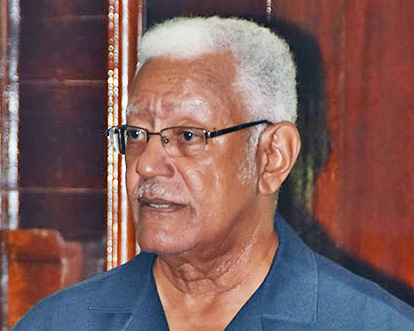
Minister of Agriculture, Noel Holder told the National Assembly that government was now targeting sugar production of 145,247 tonnes in 2020. When government last year had tabled its White Paper on the sugar industry, it had set itself a target of 174,000 annually.
However, Holder said in his contribution to the 2018 National Budget debate that with improvements in productivity, cane yields are expected to rise from the current levels of 55 tonnes cane per hectare to 78.43 tonnes cane per hectare in 2018, a 41 percent increase.
Holder said the improvement in yields would see the three remaining estates attaining close to their productivity potential. He forecasts that production will rise from 115,447 tonnes of sugar in 2018 to 145,247 tonnes in 2020, an increase of 26 percent.
Government has said that sugar production in 2017 was projected to decline to 152,000 tonnes, a 17.2 percent reduction compared to 2016’s output of 188,000 tonnes.
“Mr. Speaker, the country’s framework for governing the sugar industry has to evolve. It must become more in tune with reducing vulnerabilities, resolving institutional and legacy issues and diversifying away from sugar to more sustainable industries,” the Agriculture Minister said.
Holder said Guysuco needs GY$12 billion over the next three years – 2018 to 2020 – to ensure that production targets are met.
He noted that since winning the May 2015 general election, the APNU+AFC-coalition led government has supported GuySuCo with GY$32 billion, a $6.3 Billion allocation in 2018 and another $2.3 Billion estimated for 2019.
“Mr. Speaker, despite the magnitude of subsidies there has been no positive impact on the financial state of Guysuco. The economy simply cannot afford this,” he added.
Guysuco has begun steps to sell out Skeldon, Rose Hall-Canje and Enmore operations and diversify. Wales is already closed.
Projections are that at Uitvlugt cane farmers will account for over 50 percent of the canes supplied to the factory and every effort will be made to increase on this proportion.
Authorities also hope that the unit costs of production would decrease to 24.5USc/lb sugar (currently over 40USc/lb). There is a number of cost saving initiatives which have been identified to assist in lowering the unit cost of production even further.
Meanwhile, he announced that a European Union-funded study has shown that it is feasible to establish co-generation plants at Albion and Uitvlugt. He said excess power would be sold to the Guyana Power and Light Inc.
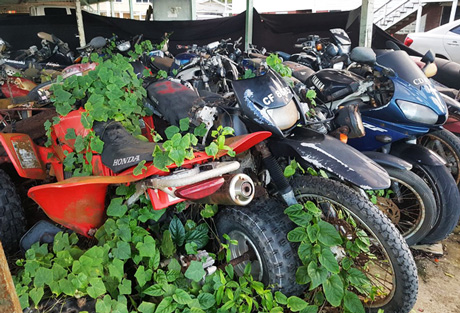
Batteries, lights, windscreen wipers, decks, mirrors, gear sticks, bicycle chains and even windscreens have disappeared from these vehicles.
Some of the affected persons have refused to make reports because of the slow pace of the investigations and the amount of time that is wasted.
A Kaieteur News report states that the majority of reported cases are from the Brickdam, Ruimveldt, Grove and the Sparendaam Police Stations. Countless incidents have also reportedly occurred at the Criminal Investigation Department (CID)’s Headquarters, Eve Leary.
When vehicles are involved in any illegal activities, they are impounded as exhibits in a station compound, closest to the scene of the crime until the matter is resolved in the courts.
Because these court matters take time, some ranks allegedly “treat” themselves. Toyota Allions, Premios, and 212 cars, and motorcycles are the most targeted.
The newspaper reports a police rank saying that when vehicles are impounded, some of his colleagues start putting their names on parts the same day.
“So what happens is if a car is involved in a robbery? They (ranks) know it will be at the station for a long time so what they do is start indicating what they need.
“I remember one time a rank examined a 212 and said he needed the deck for his car since his was stolen,” the rank said.
Kaieteur News also reported that very senior ranks in the Guyana Police Force have taken parts from impounded vehicles.
“If one of them was involved in a li’l jam up, they does come around and see which vehicle deh long and then they gon ask for the light and when you have such a senior person asking for something, what can the junior people do?” the rank stated.
In a recent case, a motorcycle was impounded at the Grove Police Station. The next day, it had disappeared. It later turned out that a junior rank had taken the cycle, claiming that he had borrowed it. A similar incident reportedly took place at the Brickdam Police Station.
One of its motorcyclists was involved in a minor traffic offence early this year. Although the matter was settled, the company had a difficult time getting back its motorcycle because it was purchased from a private individual and had not been transferred as yet. It took some four months for the company to get back the motorbike. On the day it was returned, the rider couldn’t even recognise the motorcycle, since the headlight, trafficator box and battery were missing. Nothing came out of that matter.
A senior officer at the Brickdam Police Station said when drivers notice parts are missing from their impounded vehicles; they need to make a report to the CID.
While he admitted there have been reports of stolen vehicle parts from the station compound, he stated that there were no recent cases. Additionally, he said that traffic ranks hardly impound vehicles now for the same reason.
Guysuco workers
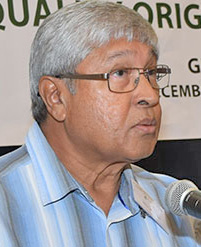
Chief Executive Officer of Guysuco, Errol Hanoman said the experts have cited the need for a good level of demand for produce to make such a project viable.
“As the consultants have pointed out to us, this whole exercise has to be market-driven or market-led because you don’t want the guys to get into growing things where the local market is saturated and there is no outlet for their produce at a viable price,” Hanoman told the news media.
With a preliminary draft report already in since the study began in September, he said the next step would be to train people who would in turn train Guysuco former employees. Hanoman said participants in the training of the trainers program would be drawn from the Guyana Livestock Development Authority and the New Guyana Marketing Corporation which have the required local expertise.
Asked whether Guyana did not have the expertise to conduct the study rather than going overseas, the Guysuco boss said it was important for foreign experts to be hired to conduct the European Union-funded study because a credible and scientific report is needed to approach international organisations to come on board.
Cautioning against believing that it is all about identifying and allocating lands to would-be farmers in an unstructured manner, Hanoman said already an unnamed international entity has signaled an interest in providing seed money in the project.
“I am sure that this knowledge exists in a fashion among us here in Guyana, but to do a proper study that is going to be market-driven and to ensure that the processes are well-documented, you have got to have people who are experienced in this and the other thing, as well, there could be international financial institutions who could be interested in providing seed-money for this type of activity so what we needed was a credible report that we could use to give to these financial institutions to sort of whet their appetite,” he said.
Questionnaires, he said, have been already distributed to workers for them to say whether they would be willing to lease lands from Guysuco and the type of agriculture or crops they would be interested in. “We are studying the results of the questionnaire, which have already been responded to, but I dare say there is further work to be done between now and the end of the year,” he said.
Junior Minister of Social Protection, Keith Scott first hinted that the study was underway in his contribution to the
2018 National Budget. He said the study was focusing on “what are some of the best options for alternative employment for some of those persons who will no longer be employed in the sugar industry…to accommodate some of those employees who will be better off with greater opportunities provided beyond just cutting cane.”
Reacting to a heckle from the opposition benches presumably only now that such a study is being conducted, Scott remarked that “now is the right time”.
Scott’s announcement comes at a time when Guysuco has been informing thousands of all categories of sugar workers at Skeldon, Rose Hall-Canje and East Demerara that they would be made redundant from December 31, 2017.
The Guyana Agricultural and General Workers Union (GAWU) and the National Association of Agricultural, Commercial and Industrial Employees (NAACIE) have already reiterated that they want government to compensate the workers.
The unions recently decided to appeal a High Court ruling against their efforts to block the closure of several of Guysuco’s operations on the basis that there was inadequate consultation, and that a Commission of Inquiry had recommended that no estate should have been closed.



To advertise in ICW call
Call 905-738-5005